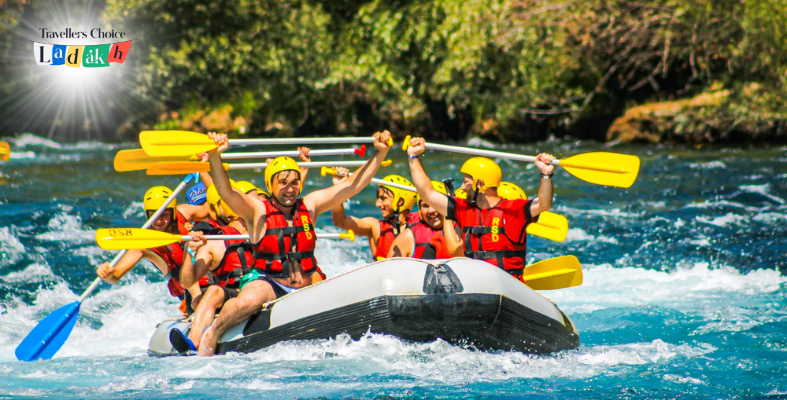River Rafting in Ladakh: Top Spots for an Adrenaline Rush
Ladakh presents itself as an adventurous destination that surpasses its reputation as a spiritual and beautiful location. River rafting stands out among all thrilling activities in Ladakh because it powerfully mixes intense adrenaline with natural beauty. The following guide presents river rafting in Ladakh, which provides distinct adventures to thrill-seekers.
River Rafting in Ladakh:
1. Indus River Rafting
Located near Kailash alongside Mansarovar Lake in Tibet sits the Indus River, known locally as Singhe Khababs (out of Lion’s Mouth). The river then continues northwest to southeast through Ladakh. The Indus River holds rapids of different levels spanning from Grade I to III, enabling rafters of all backgrounds to participate safely.
Popular Rafting Routes on the Indus:
- The main attraction of Phey to Nimo develops into a 25 km rafting destination featuring rapid intensities rated at Grade II and III. From Phey Village, which lies 12 kilometers beyond Leh, rafters embark on their path to reach Nimo, where the Indus and Zanskar rivers unite at a distance of 36 kilometers from Leh town. During the trip rafters can enjoy stunning views of both towering mountains and quaint hamlets and ancient monasteries which rest in the river valleys.
- Rafters will find the Upshi to Kharu section easy to enjoy since it contains only Grade I and II rating waters appropriate for beginners. A 90-kilometer route southeast of Leh provides rafters tranquility in front of magnificent scenic vistas.
2. Zanskar River Rafting
The Zanskar River flows head-on against the Indus River as it moves northward to the Indus before dropping its steep incline into deep valleys, including dangerous rapids and steep mountain walls. Travelers in search of extreme outdoor thrills should opt for rafting here.
Notable Rafting Routes on the Zanskar:
- Rafters consider the Chilling to Nimo route with its Grade III to V rapids to be one of the most thrilling segments, totaling 30 kilometers. People who raft down the Zanskar Gorge can experience breathtaking views while viewing both untamed wilderness and isolated Himalayan settlements.
- The Tsogsti to Sangam trail runs for an hour with Grade I+ rapids, although it remains a shorter yet more relaxing rafting journey.
3. Shyok River Rafting
Rafters have the chance to explore the Shyok River, which runs through the Nubra Valley along the Karakoram Range. The rapids of this river possess grades between II and III ratings, which suit rafters with different experience levels.
Highlights of Shyok River Rafting:
This route between Panamik and Sumur allows rafters to experience smooth water while they observe stunning views of sand dunes and monasteries and the Nubra Valley’s distinguished double-humped Bactrian camels.
White Water Rafting in Ladakh: What to Expect
White water rafting in Ladakh is defined by icy-cold waters, rapid rapids, and dramatic scenery. Glacial melting opens rivers in Ladakh, which allows rafters of all abilities to enjoy exciting rapids.
Key Considerations:
Best Time to Raft: You should experience rafting in Leh Ladakh from June through September for the best results. The river levels during this time reach their maximum capacity because glacier melt takes place which makes rafting possibilities optimal.
Safety Measures: The selection of your rafting agency should include a professional license along with safety practices. All rafters must wear life jackets according to regulations despite their swimming abilities. Any rafting participant should prepare their swimming skills before rafting and follow all orders from their designated raft leader.
What to Wear: Select quick-drying garments made with no loose accessories or belts and verify that your equipment fits properly, especially your life jacket and helmet diameters.
The Wildlife of Ladakh: A Hidden Spectacle
The magic of Ladakh wildlife enhances the exciting experience that rafting provides. Pay attention to the following river-sitting creatures when you navigate through the river pathways.
- Himalayan Marmots: These furry creatures conduct their daily sunbathing routine by resting on rocks in view of passing rafters.
- Blue Sheep (Bharal): These creatures appear during riverbank observations while they graze on steep rock faces.
- Birdlife: Rivers in Ladakh attract Black-necked Cranes and Golden Eagles and numerous seasonal waterfowl, among many other bird species.
The wildlife you see while rafting throughout Ladakh provides relaxing sightings against the intense waters to showcase the region’s abundant biodiversity.
Traveller Choice Ladakh: Your Adventure Partner
Successful river rafting in Ladakh demand detailed preparation, which becomes simpler through choosing a reliable partner. Traveller Choice Ladakh provides rafting services backed by many years of experience as well as unwavering commitment to your safety during your adventure. Adventure enthusiasts throughout the region rely on Traveller Choice Ladakh for rafting adventures because their team includes certified guides along with state-of-the-art equipment that supports they serve both novices and veterans with personalized plans.
FAQs
1. Is river rafting in Ladakh safe for beginners?
Yes! Smooth water rapids along Phey to Nimo on the Indus River make it suitable for novice rafters.
2. What is the difficulty level of Zanskar River rafting?
Zanskar River rafting features Grade III to V rapids, making it ideal for experienced rafters seeking a thrilling challenge.
3. What should I wear for river rafting in Ladakh?
The necessary attire for river rafting in Ladakh consists of waterproof clothing along with solid shoes while also removing loose jewelry. Everyone must wear a life jacket together with a helmet.
4. Can I see wildlife while rafting in Ladakh?
Absolutely! The riverbanks provide excellent opportunities for spotting blue sheep and Himalayan marmots, as well as migratory birds.
